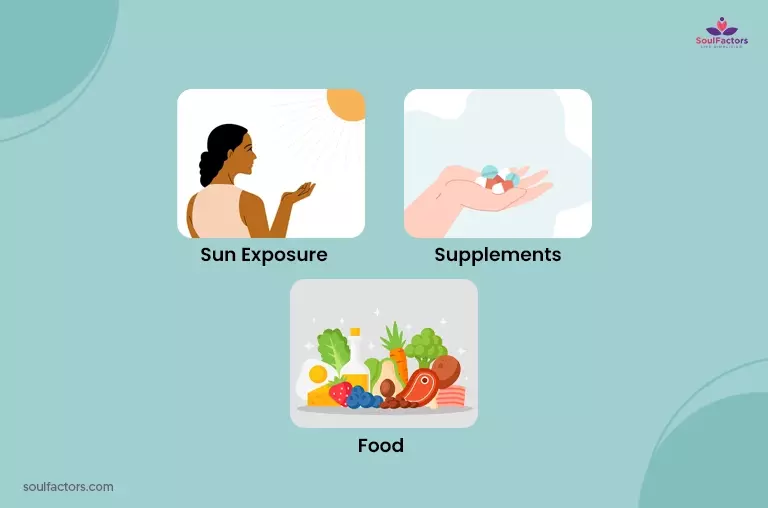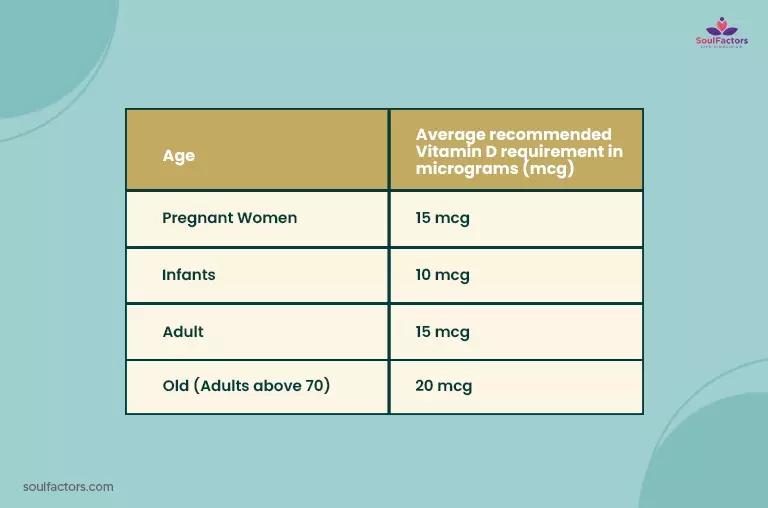How To Track And Manage Vitamin D Deficiency In Women?
Vitamin D deficiency in women is becoming common today. Body pain, stiffness in joints, back pain, and tiredness, could all be due to Vitamin D deficiency.
On Mar 3, 2023 – 9 minutes read

Vitamin D deficiency, aka “sunshine deficiency” is becoming increasingly common lately, especially in women. So how to track and manage Vitamin D deficiency in women? Anyone can get Vitamin D deficiency if they don’t receive proper sunlight or have a poor diet. The human body usually produces Vitamin D when exposed to sunlight. Some of the most common side effects of Vitamin D deficiency include osteoporosis, body pain, tiredness, and reduced bone density. Once the pandemic struck, the key role Vitamin D plays in the body’s immunity gained attention. Vitamin D is very crucial for the overall proper functioning of the body.
How To Track And Manage Vitamin D Deficiency In Women? What Is Vitamin D Deficiency?
On average, an adult body must receive around 1500 to 2000 IU of Vitamin D on a daily basis. Vitamin D is one such vitamin that is difficult to be received adequately through diet alone, thus making it the most common nutritional deficiency in the world.

When your body does not meet its Vitamin D requirement, it can lead to Vitamin D deficiency in the body. Lack of Vitamin D directly affects the muscles and bones in the body. Vitamin D is very crucial for the proper functioning and maintenance of the body, and for the development of bones. Our immune system, muscle, nerves, and bones are all linked to Vitamin D.
This article will help you understand the importance of Vitamin D and how to track and manage Vitamin D deficiency in women.
Importance Of Vitamin D In Women’s Health
Vitamin D deficiency goes unnoticed until later stages as most women don’t know, how to track and manage Vitamin D deficiency. Generally speaking, if you need a healthy body, you need Vitamin D. Vitamin D is important not just in building bones and muscles but also in keeping the calcium and phosphorus balance in check in the body. The calcium balance needs to be maintained in the blood for the body to maintain healthy and strong muscles and bones. Hypocalcemia is a condition that occurs in the body when the intestines fail to absorb enough levels of calcium and phosphorus.

When the body lacks Vitamin D to do its job, the parathyroid glands try to take charge to compensate and keep the calcium levels in the blood back to normal which leads to a condition known as hyperparathyroidism. When a person goes through a combination of both hyperparathyroidism and hypocalcemia this could lead to issues such as fatigue, cramps, and depression. Once a person’s body goes into hyperparathyroidism, the missing levels of calcium are absorbed from the bones making the bones weak and resulting in a condition known as rickets in kids and osteomalacia in adults.
So, how to track and manage vitamin D deficiency in women? If you are suffering from sleeping issues combined with fatigue, blurred thinking, muscle ache, joint pain, and depression, then you need to get your Vitamin D levels checked.
Reduced Vitamin D levels are commonly observed in women post-pregnancy. How to track and manage Vitamin D deficiency in women? should be discussed because Vitamin D deficiency in women when not identified and managed in the initial stages can put them at high risk of short-term as well as long-term health issues such as:
- Estrogen imbalance: Vitamin D deficiency in the body could lead to Estrogen imbalance in women which can lead to confusion, depression, mood swings, heat waves, etc.
- Body pain: Women with low Vitamin D levels in the body could feel tired and sore all day. This could affect the physical and emotional well-being of the woman and affect her day-to-day life.
- Insulin Resistance: The body’s natural capability to manage blood sugar levels will be affected by the lack of Vitamin D in the body.
- Weak Immune system: Vitamin D deficiency could affect a woman’s immune system making her vulnerable to illness and infections.
- Unwanted growth: Women with low levels of Vitamin D are at a higher risk of experiencing tumors and growth in the body, which could be either risky or inconvenient.
Vitamin D deficiency needs to be treated; if left untreated the situation could lead to severe and life-threatening health issues such as cancer, heart disease, and multiple sclerosis (a disease that affects and is even capable of disabling the central nervous system that connects the brain with the spinal cord).
Types Of Vitamin D
Vitamin D is commonly found in two forms that the human body can easily absorb. Vitamin D from animals is Vitamin D3 also known as cholecalciferol; and Vitamin D from plants is Vitamin D2, also known as ergocalciferol. Your doctor would analyze your condition and choose a source of Vitamin D that is most suitable for your body.
What Are The Common Sources Of Vitamin D?
Here are some of the most common sources of Vitamin D:
- Sun exposure: Sun exposure is the greatest source of Vitamin D. But the absorption of Vitamin D from the sun could vary from person to person. For example, a person with a darker skin tone tends to absorb less Vitamin D when compared to someone with a lighter skin tone. The amount of Vitamin D exposure will also depend on your location. A certain part of the world has more sun exposure than others. However, keep in mind that it is simple to get sun poisoned. To avoid sun poisoning, it is sufficient to observe basic standard precautions and sun safety advice.

- Supplements: Vitamin D deficiency is mostly compensated with the intake of Vitamin D supplements which your doctor will prescribe depending on the amount of Vitamin D you require. Never self-medicate!
- Food: there are certain food that has Vitamin D in them such as fish liver oil, fatty fish, beef liver, egg yolk, orange juice, and milk products (fortified Vitamin D)(1)
Even if one does all this they might still have a Vitamin D deficiency as Vitamin D is quite hard to absorb when compared to other forms of vitamins.
How To Diagnose Vitamin D Deficiency In Women?
Under normal circumstances, no one would get routine Vitamin D checkups unless the person has some medical conditions that could lead to Vitamin D deficiency. Most cases of Vitamin D deficiency go unnoticed till the symptoms become more severe and obvious. Here is how to track and manage Vitamin D deficiency in women:

The only way to check your Vitamin D levels is to run a blood test, one of the most common types of blood tests to diagnose Vitamin D deficiency is the 25(OH)D aka (25-hydroxyVitamin D) test.
Below is a table that shows the daily average amount of Vitamin D one required based on your age:
Understanding how to track and manage Vitamin D deficiency in women?
Once you have been diagnosed with a Vitamin D deficiency, the treatment will target getting your Vitamin D levels to the required amount as well as preventing Vitamin D levels from going down again.
While eating food rich in Vitamin D cannot increase the Vitamin D levels to the required amount, it is still advised by the doctors to have food rich in Vitamin D. Along with a diet rich in Vitamin D, the doctor might also recommend you to take Vitamin D supplements as well as spend some time outdoors(2).
Women Who Are At An Increased Risk Of Vitamin D Deficiency: Factors
- Age: Women as we age gradually become more exposed to a risk of getting Vitamin D deficiency.
- Weight: Overweight women are more susceptible to Vitamin D deficiency
- Being vegetarian: women who don’t eat fish and meat can get a Vitamin D deficiency when compared to those who eat non-veg.
- Women who do not receive enough sun exposure
- Women who develop Vitamin D deficiency as a result of other underlying diseases
Learning how to track and manage Vitamin D deficiency in women is very important as it could rob women of their energy, mental peace, and happiness. If assessed and managed once can get back to feeling better than ever.
How Can I Prevent Vitamin D Deficiency?
One of the best and easiest ways to prevent Vitamin D deficiency is to have food rich in Vitamin D and get an adequate amount of sun exposure.
Note: While sun exposure is a great source of Vitamin D make sure you don’t overdo it or stay out long without sunscreen, you might be putting yourself at a higher risk of skin cancer.
Also driving in your car will not give you Vitamin D as car windows are more than capable of blocking out the UVB rays.
Frequently Asked Questions
While the actual association between Vitamin D deficiency and heart health is yet to be identified, it has been claimed that most people who had a heart attack were also observed to have a Vitamin D deficiency. While treating Vitamin D cannot be a cure for heart disease, the association of Vitamin D with heart patients could be due to the lack of outdoor physical activities practiced by heart patients.
How to track and manage vitamin D deficiency In Women? Once you are diagnosed with Vitamin D deficiency your doctor might recommend you the dosage and type of Vitamin D supplement that would suit you the best. Do not self-medicate on any supplements as this might lead to more health concerns and also make the situation worse.
As much as your body needs Vitamin D, too much Vitamin D could be harmful. Take only the right amount of Vitamin D supplements as recommended by your doctor. Staying under the sun will not completely get rid of your Vitamin D deficiency, and too much Vitamin D can lead to hypercalcemia which could cause poor appetite, increased thirst, fatigue, constipation, weakness, balance issues, and unclear speech.
This is because, unlike other vitamins, Vitamin D absorption is quite tricky. It differs from body to body. Naturally, dark-skinned people have low Vitamin D levels when compared to those who are fair-skinned. Vitamin D absorption will also depend on various lifestyle practices like sunscreen usage, the area where you live, your everyday habits, and the amount of time you spend outdoors.
Vitamin D deficiency affects the female hormones which in turn can disrupt the menstrual cycle.
There is no fast way to cure Vitamin D deficiency one will have to take Vitamin D supplements, and bring in lifestyle and food habits changed to recover and prevent Vitamin D deficiency.
Final Thoughts
Vitamin D is one of the most important Vitamins for the overall performance of the body not just for women, but for men and children. Once identified, Vitamin D deficiency can be managed with food, sun exposure, and supplements. Hope you found this article on How to track and manage Vitamin D deficiency in women useful.
Stay healthy and enjoy some sunshine!

Subscribe to Newsletter
Elevate your routine, stay on trend, and embrace a personalized beauty journey with our curated insights.





Write a Comment